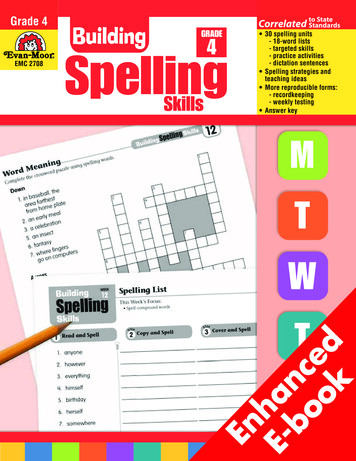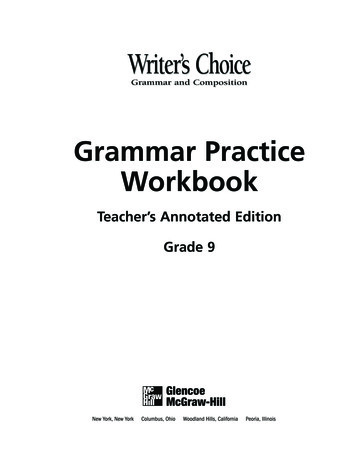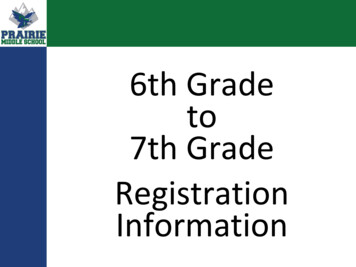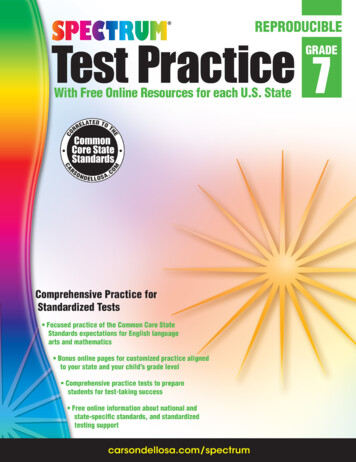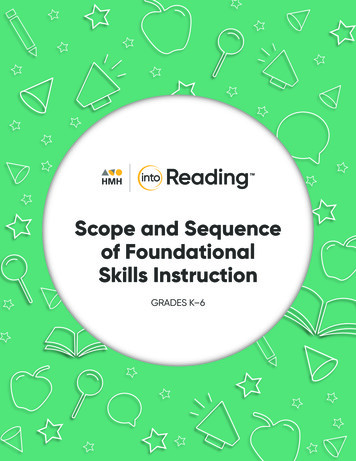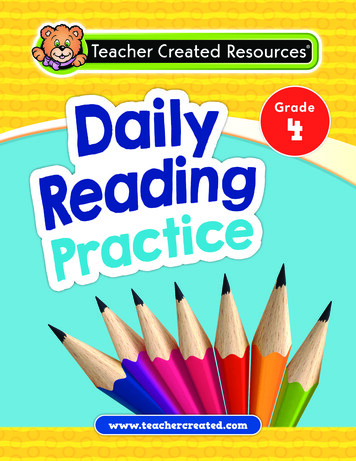
Transcription
Grade4www.teachercreated.com
Nonfiction: AnimalsName DateWarm-Up 1LadybugsHave you ever seen a small, red beetle with black dots on its back? These little insects are calledladybugs. These little insects are harmless to humans. A ladybug does not bite or sting humans.Ladybugs are also harmless to plants, and they do not carry diseases. But how did the ladybug getits name? There are many stories. One of these stories came from the Middle Ages. The crops werebeing eaten, and the villagers began praying. The red beetles with black dots came and ate the harmfulinsects. These beetles were named “the Beetles of Our Lady.” The name was shortened to lady beetlesor ladybugs.Since then, the ladybug has been known to bring good luck. There are many beliefs about ladybugsfrom all over the world. It has been said that if a ladybug lands on a young maiden’s hand, she willmarry soon. In England, it has been said that if a farmer sees a ladybug, he will have a good harvest.Some people believe that the number of spots you see on the ladybug’s back will represent the numberof children you will have.Ladybugs today can still bring good fortune. If you have a ladybug in your garden, then you do notneed to use insect poison to get rid of aphids. Aphids are tiny insects that are harmful to many plants.They suck the juice from the leaves of the plant. A ladybug can eat as many as 50 aphids in a day.Some people buy ladybugs to fight the aphids.Story Questions1. According to this reading passage, why might someone want to buy a ladybug?a. They are more expensive than insecticides.b. Ladybugs kill aphids that can be harmful to plants.c. Ladybugs bring good luck.d. Ladybugs will reproduce.2. This passage is mostly about . . .a. aphids.b. good farming practices.c. the anatomy of a ladybug.d. general information of ladybugs.3. According to the passage, what do some people believe will happen when a ladybug lands on thehand of a young maiden?4. According to the passage, what might ladybugs first have been called?a. lady in waitingc. the Beetles of Our Ladyb. lady buggled. bug of a lady Teacher Created Resources, Inc.9#3490 Daily Warm-Ups: Reading
Nonfiction: AnimalsName DateWarm-Up 2The Panda BearOne of the most unusual bears known to man is the panda bear. Panda bears live in southwesternChina. They live in misty forests of bamboo. There are two main types of pandas. They are the giantblack-and-white panda and the red panda. They weigh anywhere from 175 to 275 pounds. They getanywhere from five to six feet in height. A newborn panda cub is about the size of a chipmunk. Theyare born blind and are completely helpless. They rely heavily on their mother. Once the baby pandaleaves its mother, it will live all alone.Pandas are active during both the day and at night. The most important plant in the life of a panda bearis bamboo. They spend about 12 hours of their day eating bamboo. That’s a lot of bamboo! Pandashave special bones in their wrists that enable them to grab the stalks of the bamboo. Pandas will peelaway the outer edge of the stalk and eat the soft inner portion of the bamboo. Their giant molars crushthe bamboo stalks. The panda will also eat the bamboo leaves. Pandas have also been known to eatmushrooms, insects, grasses, fish, fruit, and rice.Pandas move in a very slow, methodical manner. Unlike some bears, the panda bear does not hibernate.They live in a climate where they can be active and eating throughout the year.Story Questions1. A different title for this reading passage could be . . .a. “Panda Paradise.”c. “All You Want to Know About Bears.”b. “China’s Bear.”d. “Illegal Bear Hunting.”2. Newborn panda cubs are not born . . .a. being able to see.b. blind.c. the size of a chipmunk.d. helpless.3. The author wrote this passage to . . .a. justify keeping pandas in captivity.b. inform the reader of how pandas are mistreated.c. share general information about panda bears.d. raise awareness of the shrinking of the panda population.4. If you wanted to find out more about pandas, you could . . .a. read a book about how bears hibernate.b. watch a television program about bamboo.c. meet somebody who lives in China.d. watch a television program about the different types of bears.#3490 Daily Warm-Ups: Reading10 Teacher Created Resources, Inc.
Nonfiction: BiographyName DateWarm-Up 1Walt DisneyWhere is “the happiest place on earth”? Some say it is Disneyland! Do you know the person whocreated this amazing theme park? He was a man named Walt Disney. Walt Disney was a pioneer inmotion pictures. He also created Mickey Mouse and the Disney World theme parks. Walt Disneyreceived hundreds of awards from all over the world.Walt Disney was born in Chicago, Illinois. He was raised on a farm in Missouri with four othersiblings. Walt’s parents, Flora and Elias Disney, encouraged his creativity and sketches and drawings.Walt sold his first sketches at the age of seven.After serving some time in the Red Cross, Walt got a job as an advertising cartoonist. This was wherehe marketed and created his first animated cartoon. In 1925, Walt married Lillian Bounds. They hadtwo daughters. Another important member of the family was brought to life in 1928. That was MickeyMouse.Walt perfected the combination of animation and sound. Snow White and the Seven Dwarfs wascreated in 1937. Since then, the Disney name has gone on to produce hundreds of animated movies.Story Questions1. What are the author’s feelings about Walt Disney?a. indifferentc. unsureb. disapprovesd. admires2. Which sentence shows how the author feels about Walt Disney?a. Walt married Lilian Bounds.b. Disney was born in Chicago.c. Walt Disney perfected the combination of animation and sound.d. Walt got a job as an advertising cartoonist.3. Which sentence is not an example of the encouragement Disney received through the years?a. He got a job at an advertising agency.b. He invented Mickey Mouse.c. His parents encouraged his creativity.d. He received awards from all over the world.4. What is the meaning of word pioneer in this passage?a. trailblazer of new ideasc. traveled across the plainsb. workerd. nomads Teacher Created Resources, Inc.25#3490 Daily Warm-Ups: Reading
Nonfiction: BiographyName DateWarm-Up 2Helen KellerCan you imagine what it would be like not to be able to see or hear? When Helen Keller was 19months old, she became very ill. Doctors expected her to die, but she survived. Helen’s mother soonnoticed that Helen was not responding when the dinner bell rang or when she waved her hand in frontof Helen’s face. It then became apparent that Helen’s illness had left her blind and deaf. She was bornon June 27, 1880 in Alabama, where she lived with her family. She was frustrated and confused. Shedidn’t know what was going on in her world. Her parents knew that they needed help. They hired atutor for Helen. Her name was Anne Sullivan.Success didn’t happen right away. But one day at the water pump, a breakthrough happened. Annespelled the word water in Helen’s hand. Helen began to catch on. Suddenly, her brain was on fire.She reached down to touch the ground, and Anne spelled the word earth in her hand. She continuedpointing and learning. She learned to spell 30 words on that day.By the age of 10, Helen had learned to speak by feeling her teacher’s mouth when she talked. Somepeople couldn’t understand Helen, but she kept trying. She learned to read French, German, Greek, andLatin in Braille. Braille is a way for people who can’t see to read. Raised dots are used to representletters and words. Soon Helen could read, write, and speak.Helen Keller went on to give speeches all over the world. Most of the money she earned was given tothe American Foundation for the Blind. She met 12 U.S. presidents, wrote a dozen books, and went tocollege. Helen Keller lived to be 87. She continues to inspire many people worldwide.Story Questions1. Why was Helen Keller so successful in life?a. People felt sorry for her and took pity on her.b. She eventually got her vision and hearing back.c. She learned to overcome obstacles and work hard.d. She was able to meet 12 U.S. presidents and speak worldwide.2. What can you learn about Anne Sullivan from reading this passage?a. She traveled the world to give speeches.b. She was diligent in her efforts with Helen Keller.c. She was blind herself.d. She was placed in an orphanage.3. According to the passage, which of the following statements is true?a. Helen Keller was unable to overcome great obstacles to do great things.b. Helen Keller didn’t have to work hard to succeed.c. Helen’s parents made the right choice in hiring Anne Sullivan.d. Blind people can be taught how to read Braille, but not deaf people.#3490 Daily Warm-Ups: Reading26 Teacher Created Resources, Inc.
Nonfiction: American HistoryName DateWarm-Up 4Man on the MoonThe space race was on to see which country would be the first to put a man on the moon. The U.S.S.R.had put the first satellite into space. It was called Sputnik. The United States was working hard to geta man on the moon. It was a tough goal. This had never been done before. After years and years ofhard work, it finally happened.Neil Armstrong was the first man ever to step on the moon. His famous words were, “That’s one smallstep for man, one giant leap for mankind.” The date was July 20, 1969. Pictures and stories of thisfamous and historic event were found in newspapers around the world. There were pictures of theastronauts’ footprints on the moon. Millions of people watched the event on television.Buzz Aldrin was also with Armstrong on the voyage to the moon. Each of them spent hours on themoon doing tests and taking samples. The surface of the moon was fine and powdery. There is littlegravity on the moon, so the two men were able to walk and hop freely on the surface. They also postedthe American flag on the moon. There is no wind on the moon, so their footprints might still be there!Story Questions1. What type of accomplishment was putting a man on the moon?a. general accomplishmentc. difficult accomplishmentb. sad accomplishmentd. disappointing accomplishment2. What conclusions can be drawn about the first trip to the moon?a. It was a mission fraught with arguments and disagreements.b. It was a successful mission.c. It was an experience never to be repeated.d. It was an unorganized mission.3. Which of the following statements about the moon is not supported by information in the passage?a. There is little gravity on the moon.b. There is plenty of water on the moon.c. The surface of the moon is fine and powdery.d. Neil Armstrong was the first man on the moon.4. What is the meaning of the phrase “one giant leap for mankind” as used in the passage?a. It was a huge accomplishment and learning opportunity for humankind.b. It was an example of their willingness to sacrifice for humankind.c. Humankind would soon be making those same steps.d. There was not a lot learned from the experience.#3490 Daily Warm-Ups: Reading44 Teacher Created Resources, Inc.
Nonfiction: American HistoryName DateWarm-Up 5The Gettysburg AddressPerhaps the most famous battle of the Civil War was the one in Gettysburg, Pennsylvania. At theend of the battle, over 50,000 soldiers were wounded, missing, or killed. The Union and Confederatearmies had each lost thousands of men. Many of the bodies were buried in shallow graves along thebattlefield. The Union army wanted to do better than that.The Union army was able to get land for a cemetery in Gettysburg. This cemetery was dedicated inNovember of that year. Edward Everett was asked to speak at the dedication. He was a great speakerof that time. President Abraham Lincoln was also asked to speak. He was the president during theCivil War.On the day of the dedication, Mr. Everett spoke for two hours. When it was President Lincoln’s turn,he spoke for two minutes. He didn’t think it was a very good speech, but it went on to be consideredone of the greatest speeches of all time. It became known as the Gettysburg Address. In his speech,Lincoln talked about the “new birth of freedom.” His words inspired many people then, and theycontinue to inspire many people today.Story Questions1. What would be the best title for this reading passage?a. “Mr. Everett’s Speech”c. “Lincoln’s Famous Address”b. “The Dedication of the Cemetery”d. “Union and Confederate Soldiers”2. What conclusions can be drawn about the battle of Gettysburg?a. It was one of the deadliest battles of the Civil War.b. It was a pivotal battle at the beginning of the war.c. President Lincoln approved of the battle.d. It was fought in a poor location.3. Which statement explains why President Lincoln’s speech was so well received?a. It inspired people to keep fighting.b. It inspired people to go home and think.c. It was used to encourage the wounded and dying soldiers.d. It inspired people to think about their freedoms and reasons for fighting.4. What is the meaning of the phrase “new birth of freedom” in the passage?a. It is the idea that we are connected and shouldn’t pull apart.b. It is a willingness to sacrifice and stick together.c. It is the idea that there was a new idea of freedom coming to light.d. It is the idea that you should never give up or turn away when times are tough. Teacher Created Resources, Inc.45#3490 Daily Warm-Ups: Reading
Nonfiction: ScienceName DateWarm-Up 2The Central Nervous SystemThe adult brain weighs about three pounds. This doesn’t seem like much, but it is one of the mostimportant organs in the human body. The brain is made up of millions of nerve cells. These nerve cellstell the rest of the body what to do. Without a brain, we could not live. The spinal cord is connected tothe brain. It runs from our neck down through our back. The spinal cord and the brain make up whatis called the central nervous system.The brain is like the body’s computer. It controls body temperature and reminds us to breathe.The brain allows the body to have voluntary movement, thought, language, and reasoning. Differentparts of the brain have different jobs. The brain tells us when we are hungry and thirsty. It also isresponsible for memory and emotion.Our brain relies on food to give it energy. You need to eat healthy foods to keep your brain and therest of your body working right. Healthy foods like fruits, vegetables, cereals, grains, milk, and otherdairy products are all important foods for us to eat. We also need to keep our brains active. Researchhas shown that the less active our brain is, the less we are able to remember and do. So keep thinking,moving, and doing. It’s great for your brain.Story Questions1. After reading the passage, what do you think would happen if your brain was injured?a. It would immediately double in size.b. Our bodies might not be able to perform certain things.c. The heart would begin to take over the body.d. Doctors have not yet determined what happens in this case.2. The main idea of this passage is . . .a. to inform the reader about what happens when they are thinking.b. to inform the reader about the connection between the heart and brain.c. to inform the reader about how important healthy food is to the brain.d. to share general information about the brain and the spinal cord and how they work.3. Where can you find information about the spinal cord?a. second paragraphb. not in the passagec. third paragraphd. first paragraph Teacher Created Resources, Inc.57#3490 Daily Warm-Ups: Reading
Nonfiction: ScienceName DateWarm-Up 5Earth’s AtmosphereWhat do you know about Earth’s atmosphere? Earth’s atmosphere is a thin layer of gases that coverthe outer edge of Earth. It is mostly made up of nitrogen and oxygen. There are other gases in theatmosphere as well. This layer of gases is very important. It protects Earth from extreme temperatures.The atmosphere also traps heated air. It protects Earth from the sun’s ultraviolet rays. These rays canbe very harmful.The atmosphere is about 300 miles thick. It slowly becomes thinner the farther it is from Earth andfades off into space. There isn’t a real defined boundary between the atmosphere and space.Oxygen in the atmosphere is important. Oxygen allows us to breathe. Without oxygen in the air, wewould not be able to live. Some of the oxygen has changed over time. This is called the ozone layer.Some experts believe that humans have caused a hole in ozone layer.The atmosphere is divided into five layers. The weather we experience on Earth takes place in the firstlayer. Weather happens because the atmosphere is constantly moving and changing.Story Questions1. Where does the weather we experience on Earth take place?a. in the atmosphereb. in the first layer of the atmospherec. in the second layer of the atmosphered. in the ozone layer2. Which paragraph helps you answer the previous question?a. second paragraphb. first paragraphc. fourth paragraphd. third paragraph3. Without the atmosphere, what would happen to Earth?a. It could not withstand the sun’s ultraviolet rays.b. There would be no weather patterns.c. There would be less pollution.d. The ozone layer would not have a hole in it.#3490 Daily Warm-Ups: Reading60 Teacher Created Resources, Inc.
Nonfiction: Current EventsName DateWarm-Up 2LitteringIt is very sad to see litter on the highways or in parks and other public places. Littering is a bigproblem that needs to be stopped. There is no reason why people need to litter. Someone who litters isa lazy person. It means he or she is too lazy to get up and throw away his or her own trash.Many things have been tried to stop people from littering. Laws have been passed to try to preventlittering. If someone is caught littering on the highway, he or she can be fined to pay for it. This seemsto discourage some people, but certainly not everyone.Littering can cause a lot of problems. Littering can be harmful to the wild animals that live in the parksand forests. Littering can kill animals or make them sick. Sometimes food is left with trash and otherthings. Wild animals eat this food, and then sometimes they get sick. Littering also looks bad. It’shard to enjoy nature when it is serving as a trash can for us!Story Questions1. What is the author’s opinion about littering?a. tolerantc. disgustedb. patheticd. annoyed2. Which of the following sentences clarifies the how the author feels about littering?a. This seems to discourage some people from littering.b. It is very sad to see litter on the highways or in parks.c. There should be a fine for everyone who litters.d. Littering is more and more common today.3. Which of the following is not an effect of littering?a. Littering is harmful to animals.b. Animals can get sick and die from litter.c. Littering looks bad.d. People can get paid if caught littering.4. Who does the author blame for littering?a. the audienceb. lazy peoplec. wild animalsd. children Teacher Created Resources, Inc.73#3490 Daily Warm-Ups: Reading
Nonfiction: Current EventsName DateWarm-Up 6School UniformsDo you like to go school shopping each year? For many students, school shopping just isn’t necessary.These students go to school where school uniforms are required. School uniforms are typically awhite shirt with dark pants or a skirt. There is no need to check out the local ads for the new stylesor trends—these children already know what they will wear on the first day of school long before itarrives.Some people feel that uniforms are not a good idea. They think that children should be able to have achoice in what they wear. Wearing uniforms seems too strict. Bad behavior doesn’t happen because ofthe clothes they are wearing. Uniforms can be a hassle. Some people feel that they are uncomfortable.It can be boring to wear the same thing every day.On the other hand, many people agree with student uniforms. These people feel that uniforms makeall students feel safe and comfortable. You don’t have to worry about gangs when everyone is wearingthe same uniform. Behavior improves when students wear a uniform and dress nicely. Uniformscan also be much cheaper than the latest fads. Some say that uniforms are easy to wear, and they arecomfortable, too.So what is your opinion?Story Questions1. What is the main idea of the third paragraph about school uniforms?a. School uniforms may be a good idea.b. School uniforms show school spirit.c. School uniforms can be expensive.d. School uniforms are uncomfortable, but they keep the students in line.2. What is one of the reasons presented in the passage that supports the idea that student uniformsimprove student behavior?a. Students are more comfortable in school uniforms.b. There are winter and summer uniforms available.c. Students can’t wear gang-related clothing if school uniforms are the rule.d. Students feel safe at school because the uniforms are protective gear.3. Which statement shows that the author is trying to appeal to the parents in the audience?a. Wearing uniforms seems too strict.b. Uniforms can be much cheaper than the latest fads.c. Uniforms are easy to wear and comfortable.d. Uniforms can be a hassle. Teacher Created Resources, Inc.77#3490 Daily Warm-Ups: Reading
Fiction: Fairy Tales/FolkloreName DateWarm-Up 2The Race of the WolvesThere once were two wolves named Sam and Seneca. Sam and Seneca did everything together. Theywould race around the forest, competing against each other constantly. One day Sam was racing as fasthe could to get across the forest before Seneca. He dug his heels into the dirt and was as fast as thespeed of lightning. Seneca was not far behind. She was mad that she was behind. She was growlingas she ran. But alas, Sam won the race.The following morning, the two challenged each other to another race. Seneca was not about to letSam beat her this time. So she got up early and did a practice run. When the time of the race came,she felt fit and ready. A bird in the tree sounded the start of the race and the two were off. They wereflying through the forest at dizzying speeds. For the first time, Seneca was outrunning Sam. She wasgaining more speed as they raced, and Sam was getting upset.Up ahead on the trail was a family of quails. The proud parents were taking their little babies out fortheir first walk. They had no idea of the thunder and pounding just moments away.As the wolves rounded the bend, Seneca could see the covey of quail. For a split second she chose toignore them, but she could not. She skidded to a stop just in the nick of time. Sam came close behindher. He did not stop. He saw this as his chance to sail past Seneca. He narrowly missed the last littlequail. At the end of the race, Sam questioned Seneca as to why she stopped. She confidently replied,“It’s better to be safe than sorry.”Story Questions1. What is a “covey” of quail?a. small group or familyb. organizationc. massd. hierarchy2. How is Seneca’s behavior an example of how it’s better to be safe than sorry?3. Which sentence shows that an accident was likely to occur?a. They were flying through the forest at dizzying speeds.b. He narrowly missed the last little quail.c. She was gaining more speed as they raced and Sam was getting upset.d. The proud parents were taking their little babies out for their first walk.#3490 Daily Warm-Ups: Reading90 Teacher Created Resources, Inc.
Fiction: Fairy Tales/FolkloreName DateWarm-Up 4cooking for turkeyThere once was a chicken, a duck, and a goose. These three were the best of friends, but their bestfriend of all was Mr. Turkey.One morning, Mr. Turkey awoke with the flu. He was sicker than he had ever been. He could barelybreathe, and his feathers were all limp. Mr. Turkey’s friends knew that he needed help and he needed itfast.Each friend independently decided to help Mr. Turkey. The goose got a big pot and put it on the fire.She was going to cook a nice broth for Mr. Turkey.The chicken also wanted to feed Mr. Turkey, but she had it in her mind to make a turnip pie. She wastickled when she saw the pot on the fire and threw her turnips in to boil.The duck wanted to help Mr. Turkey as well. He came in and saw the pot on the fire and the turnipsinside. He decided to add some cinnamon to the pot to make his sugary cinnamon tea. Each friend, inturn, came and added more ingredients to the pot. It wasn’t long before Mr. Turkey hobbled into theroom.“What’s that awful smell?” he asked. His three friends entered the room with hurt looks on their faces.They couldn’t believe what their friend had said—until they too looked in the pot. With a laugh theyall said, “I guess it’s true. Too many cooks spoil the broth!”Story Questions1. What does the word independently mean in the story?a. artisticb. separatelyc. thoughtfullyd. organized2. Which paragraph contains Mr. Turkey’s response to the boiling pot?a. fifth paragraphc. third paragraphb. second paragraphd. sixth paragraph3. Which of the following would make a good title for the story?a. “Caring for Mr. Turkey”c. “House Visit”b. “Turkey, Goose, and Duck”d. “Turkey Tea”4. Which of the following idioms goes with the story?a. Never count your eggs before they hatch. c. Too many cooks spoil the broth.b. Wash your hands before dinner.#3490 Daily Warm-Ups: Reading92 Teacher Created Resources, Inc.
Fiction: HistoricalName DateWarm-Up 1Civil LoveSweat was dripping down Mary’s neck. It was the year 1864, and Mary was helping the woundedsoldiers as they came into camp. It was the saddest thing she had ever seen. Most of the men werevery young. Mary spent countless hours helping and healing. The hours were endless.As Mary walked towards the back of the room, she quickly smiled at little Elizabeth. Elizabeth satin the corner watching Mary’s every move. She had gotten separated from her family. They werenowhere to be found. Mary had taken her in and cared for her like a daughter. She rocked the girl atnight as she cried and cried for her momma. During the day, little Elizabeth was Mary’s helper. Sheran and got things as quickly as she could. She seemed to anticipate Mary’s every need.“Do you want to help me?” Mary asked the little girl.“Me?” Elizabeth pointed to herself in surprise.“Yes, you!” replied Mary. Mary asked Elizabeth to gather cloths to wipe the sweat and blood off thesoldiers as they came in. Elizabeth hurried to the task, helping the soldiers.The next morning the captain came in to say that Elizabeth’s mother was found but that she wouldn’tbe able to arrive for few more days. Elizabeth shouted with glee. She was excited to be back with hermom. But for now, she had work to do.“Come on, Miss Mary. We have work to do,” Elizabeth said.Story Questions1. Which sentence contains evidence that the story takes place during the Civil War?a. The hours were endless.b. It was the year 1864, and Mary was helping the wounded soldiersc. The sweat was dripping down Mary’s neck.d. Most of the men were so young.2. Which paragraph explains the circumstances in which Mary was living?a. first paragraphc. fourth paragraphb. second paragraphd. third paragraph3. Who is the main character of the story?a. Elizabeth’s motherb. Elizabethc. Maryd. Captain4. What is the meaning of the word anticipate as used in the story?a. unbiased and disinterestedc. know in advanceb. impressed and appreciatived. not care for Teacher Created Resources, Inc.105#3490 Daily Warm-Ups: Reading
Fiction: HistoricalName DateWarm-Up 5The Gettysburg AddressOn November 19, 1863, President Lincoln had been invited to speak at a dedication of a Civil Warcemetery. The Civil War was still in the middle of being fought. Thousands and thousands of soldiershad been killed at Gettysburg, and land had been obtained to bury the dead.Rebecca had read about the event in a local newspaper. She didn’t live far from Gettysburg, and shewanted to go! She begged her parents for a week before they finally relented.Early on November 19, Rebecca and her father took the quick trip to Gettysburg. She admiredLincoln’s bravery and his courage. It had been a dream of hers to one day meet the president. Thiswould be the day.Rebecca didn’t realize how long it would take. Mr. Everett, the first speaker, spoke for two hours.Rebecca thought she was going to die as she sat fidgeting in her seat.Then it was time for President Lincoln. He rose from his seat and began his speech. Rebecca wasenthralled. She loved his words about freedom. President Lincoln spoke for just two minutes.Rebecca couldn’t believe it. She jumped out of her seat and ran to the stage. She just had to meet Mr.Lincoln. President Lincoln’s bodyguard stopped her, but Mr. Lincoln beckoned her to join him for aminute.Walking back to the wagon, Rebecca stared at her hand. “I’ll never wash it, Dad, never.” Her dadsmiled and loaded her into the wagon.Story Questions1. What was it specifically that Rebecca liked about Mr. Lincoln?a. She knew that he would remember her.b. She liked him just because he was president.c. She liked his words about freedom.d. She thought he was nice looking.2. What is the main idea of the fifth paragraph?a. Rebecca was finally able to meet President Lincoln.b. Rebecca learned about the Civil War.c. Rebecca was planning a trip to Gettysburg.d. Rebecca begged her parents for permission.3. What is the meaning of the word fidgeting in the fourth paragraph?a. settlingc. botheringb. unconcerningd. squirming Teacher Created Resources, Inc.109#3490 Daily Warm-Ups: Reading
Fiction: Contemporary RealisticName DateWarm-Up 1Spelling BeeMiranda had studied the words for the spelling bee for two weeks straight. Each class in school was tosend a student to part
#3490 Daily Warm-Ups: Reading 10 Teacher Created Resources, Inc. The Panda Bear One of the most unusual bears known to man is the panda bear. Panda bears live in southwestern China. They live in misty forests of bamboo. There are two main types of pandas. Th




